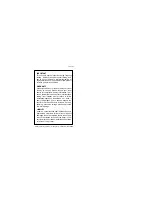
in memory. Pressing on any key except [2
ND
] will
return the keypad to normal zone display.
Trouble conditions will remain in "trouble" memory.
Pressing on the [2
ND
] key displays current trouble
conditions. Pressing [
CLEAR
] will erase trouble condi-
tions in memory.
Control panel software versions 2.00 and beyond:
Keys that illuminate in “trouble display” mode indicate the
trouble conditions currently taking place. Press on any
key to return keypad to normal zone display.
Key [1]
No battery/low battery
If battery is not connected to control panel, or if it is at
low capacity, key [1] illuminates. This means that the
battery connected to panel should be replaced because
it can no longer provide adequate back-up current in
the event of a power failure. Trouble indicator [1] will
also illuminate if battery voltage drops to 10.5 volts
while panel is running on battery power (with no AC).
Key [2]
Power failure
(Control panel software versions 1.4 and beyond)
If AC power is not being supplied to the panel and/or
the power supply is unable to charge the battery and/or
the power supply voltage exceeds 14.9 volts, key [2]
will illuminate. Power failure can be excluded from key
[
TRBL
] display by your installer. When a “power supply
failure” trouble occurs, [
TRBL
] key flashes rapidly.
Key [3]
AC power failure
(Control panel software versions prior to 1.4)
If AC power is not being supplied to the control panel,
key [3] will illuminate. AC trouble can be excluded from
keypad "trouble display" by your alarm installer.
Key [4]
Bell disconnect
If a bell or siren is not connected to the bell/siren out-
put, this is indicated by the illumination of key [4] in
trouble display mode.
Key [5]
Maximum bell current
If key [5] illuminates, it indicates that the processor
has recognized that the bell/siren output current
exceeds 3A. This causes automatic shutdown of the
bell output. Once the problem is corrected, power will
automatically be restored to the bell/siren circuit.
Key [6]
Maximum auxiliary current
Key [6] illumination indicates that the processor has
recognized auxiliary output current exceeds 1A. This
causes automatic shutdown of the auxiliary output.
Once the problem is corrected, power will automati-
cally be restored to the auxiliary output. This output
powers such devices as motion detectors and acces-
sory modules.
Key [7]
Communicator report failure
If your control panel cannot communicate with the
central monitoring station, key [7] illuminates.
20
21
UM616-626
UM616-626





































